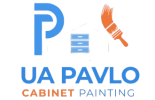Day 3 of our kitchen cabinet transformation has officially wrapped, and the project is now heading into the home stretch! If you’ve been following along, we’ve already masked, degreased, and disassembled. Now, it’s time to seal the surface and lay the invisible foundation that ensures durability, adhesion, and beauty.
Today’s focus: Priming and surface sealing — one of the most important (and underestimated) parts of professional cabinet spray-painting.




Why Primer Matters (Especially in Canadian Homes)
You wouldn’t put shingles on a roof without plywood underneath. The same logic applies to paint: No high-end finish will last without the right primer.
Canadian kitchens go through:
Dry winter heat
Humid summer air
Constant temperature swings
Daily exposure to steam, oils, and cleaning products
Without a proper bonding primer, paint can crack, peel, or stain. That’s why we never skip — and never cheap out — on priming.
Step 1: Surface Scuff-Sanding
Before we prime, we prep the prep:
All surfaces are lightly sanded using fine-grit sanding sponges to create a mechanical tooth — that slight texture the primer needs to grip.
Dust is fully vacuumed and tack-clothed away. No specks, no shortcuts.
Edges, grooves, and panel insets are hand-sanded with detail tools — because spray-painting exposes everything.
In short: we make the surface slightly rough, not visibly, but functionally — perfect for bonding.
Step 2: Primer Application (The Real Game-Changer)
For this project, we used a high-adhesion, stain-blocking primer, designed specifically for cabinetry and woodwork. Why?
Seals in old finishes (especially important for dark brown cabinets)
Blocks wood tannins from bleeding through into white paint
Builds a smooth, consistent base for topcoat spraying
Cures to a sandable finish, ready for a glass-smooth second day of painting
We applied two coats of primer using our HVLP (High Volume Low Pressure) spray system, allowing ample drying time in our ventilated, dust-free booth. No brushes. No rollers. Just a smooth, factory-quality coat.
Drying & Sanding Between Coats
Canada’s weather is always a wild card — but we control the paint environment.
Drying was accelerated with air movers and controlled humidity
Each primer coat was lightly sanded between layers to remove microbubbles or raised grain
Every surface was inspected under bright LED lighting to catch imperfections invisible to the naked eye
This isn’t paint-by-numbers. It’s surface engineering.
Pro Tip: How to Spot a Bad Primer Job
If you’re shopping around for cabinet painters in Toronto, Vancouver, or anywhere across Canada, ask how they prime.
🚫 Red flags:
One coat of all-purpose wall primer
No sanding between coats
Priming only visible surfaces
Using brushes or rollers
✅ What we do:
Two coats of cabinet-specific bonding primer
Full coverage, including edges and backs
Machine-sprayed for flawless adhesion
Considering a Kitchen Makeover?
If you’re a Canadian homeowner wanting to:
Brighten your kitchen
Avoid the mess and cost of a full gut-job
Add value before listing your home
…our spray-painting process is your fast-track to a modern, magazine-worthy space.











